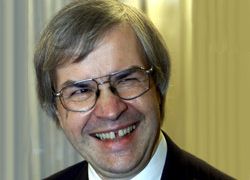Physics Nobel for German, Americans
Americans John Hall and Roy Glauber and German Theodor Haensch have won the 2005 Nobel Prize in physics for their work in advancing the precision of optic technology that could lead to clear long-distance communication worldwide and beyond.

The prize was given for the trio separately on Tuesday, yet their work in advancing optic technology to make lasers, GPS technology and other methods more accurate and concise in their readings is similiar.
Hall, 71, of the University of Colorado, and Haensch, 63, of the Ludwig-Maximilian-Universitaet in Munich, won “for their contributions to the development of laser-based precision spectroscopy, including the optical frequency comb technique” while Glauber, 80, of Harvard, won for his contribution to the quantum theory of optical coherence.
Hall and Haensch will split the 10 million kronor ($1.3 million) prize with Glauber.
Speaking from his office in Munich, Haensch called the award a high point of his career.
“I was speechless but of course very happy, exuberant,” he said. “Now, I am trying to get used to this.”
Better communications
He said the fruits of the trio’s work could eventually be applied to making communication across the globe – and beyond the earth – more feasible and make the frequencies that carry radio waves, cell phone calls and data more precise.
|
“I was speechless but of course very happy, exuberant … now, I am trying to get used to this” Theodor Haensch, |
“Eventually, we may be able to enjoy three-dimensional holographic movies,” he said.
Glauber’s theories helped to explain the behaviour of light particles, while Hall and Haensch were able to determine the frequency of light with extreme precision, the academy said.
“The important contributions by John Hall and Theodor Haensch have made it possible to measure frequencies with an accuracy of 15 digits,” the assembly added. “Lasers with extremely sharp colours can now be constructed and with the frequency comb technique precise readings can be made
of light of all colors.
Improved GPS
“This technique makes it possible to carry out studies of, for example, the stability of the constants of nature over time and to develop extremely accurate clocks and improved GPS technology.
Of the six Nobels, the physics prize has perhaps the broadest scope of research, making speculation ahead of the announcement difficult.
Alfred Nobel, the wealthy Swedish industrialist and inventor of dynamite who endowed the prizes, left only vague guidelines for the selection committee, saying in his will that the prize should be given to those who “shall have conferred the greatest benefit on mankind” and “shall have made the most important discovery or invention within the field of physics.”
In the past decade, winning physics discoveries have ranged from explaining the makeup of faraway galaxies to creating high-speed electronics that led to breakthroughs in how information is transmitted worldwide at superfast speeds.
Last year’s prize was given to Americans David Gross, David Politzer and Frank Wilczeck for their explanation of the force that binds particles inside an atomic nucleus.
Nobel awards
 |
|
Hans Jorvall is the secretary of |
The prize is the second Nobel to be announced this week. On Monday, Australians Barry Marshall and Robin Warren won the 2005 Nobel Prize in physiology or medicine for proving, partly by accident, that bacteria and not stress was the main cause of painful ulcers of the stomach and intestine.
The awards for chemistry, peace and literature will be announced through the end of the week, with the economics prize to be awarded on 10 October.
The prizes include a check for 10 million kronor (US$1.3 million), and will be awarded by Sweden’s King Carl XVI Gustaf at a ceremony in Stockholm on 10 December.